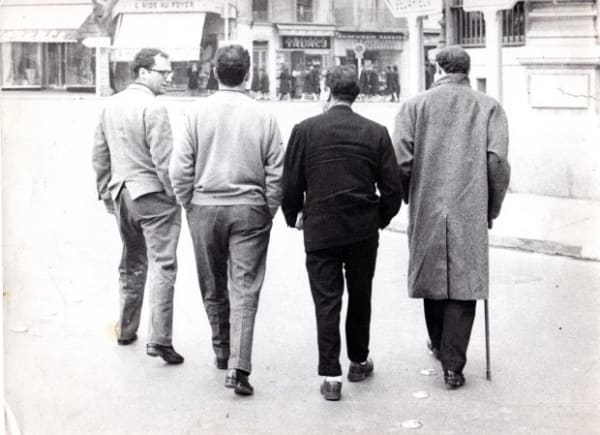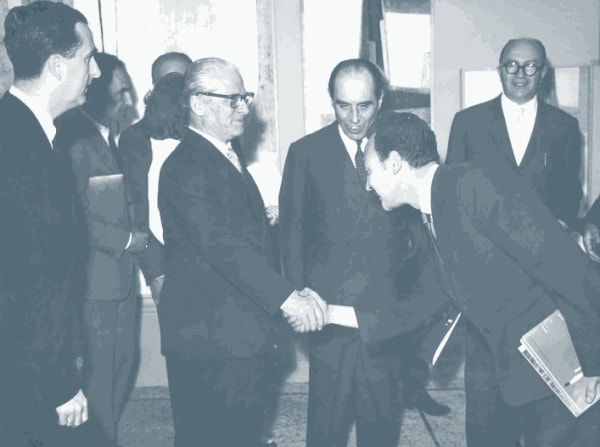Venezia 1958: BARCELONA
Barcelona, 26 September 2019: In the exhibition Venezia 1958 the Galeria Mayoral in Barcelona commemorates the Spanish Pavilion at the 1958 Venice Biennale of Art, an episode that became a turning point in the international recognition of postwar Spanish art. The show, which will be on view from 26 September to 4 December, reunites, more than sixty years after the event, ten of the artworks included in that exhibition by the artists Antoni Tàpies, Eduardo Chillida, Rafael Canogar, Manolo Millares, Antonio Saura and Manuel Rivera, all of them proceeding from important Spanish and international collections. This project is the main exhibition in the celebration of the gallery’s 30th anniversary.
The exhibition exclusively re-examines, for the first time, an episode that was crucial to the history of Spanish art of the second half of the 20th century and constituted a breakthrough for both the dissemination of Spanish Informalist art and the artists themselves who took part. As well as recouping and exhibiting some of the artworks that were shown in Venice in 1958, the aim of the project is to analyse the relevance and the consequences of the event, which took place at a time when the Franco regime was particularly interested in presenting a modern image to the outside world.
The Venezia 1958 exhibition has reunited ten artworks that are highly representative of the Biennale show. On display by Antoni Tàpies are two purely materic works dating from 1958, Brown and Ochre Painting and Blackish Brown; by Millares, three of his burlap paintings; by Chillida, a relief and a bronze sculpture, Trembling Irons III; an abstraction by Canogar from 1957; a composition on canvas with metal mesh by Manuel Rivera from 1957; and the 1957 painting Salvatierra by Antonio Saura, from the Damas (Ladies) series.
The triumph of modernity
The exhibition in the Spanish Pavilion at the 29th edition of the Biennale in 1958 was curated by Luis González Robles, who skilfully and intentionally made a selection of artworks and of artists that clearly intermeshed with the international artistic trends of the moment, above all with Informalism, which was triumphing in Europe and the United States. An attempt was made, thereby, to present an image of modernity within Spanish art at an international level and to widely disseminate the work of young artists who had opted for abstraction and the avant-garde.
Working for the Office for Cultural Assets of the Ministry of Foreign Affairs, Luis González Robles (1916-2003) was the main figure in charge of the organization of official exhibitions of Spanish art abroad during the 1950s and 60s. A great expert on the artistic reality of the country and also on international trends, González Robles had, prior to Venice, already curated the earlier participation of Spanish art in such international artistic events as the first edition in 1955 of the Art of the Mediterranean Biennial in Alexandria and the 1957 Hispano-American Biennale in São Paulo.
The definitive consecration of modern Spanish art abroad would, however, arrive with the Spanish pavilion for the Venice Biennale of 1958. In his choice of works for the latter González Robles prioritized “the expressive gesture of the Informalists,” as the Doctor of Art History María Dolores Jiménez-Blanco argues in the essay published in the Galería Mayoral catalogue of the exhibition. In his introductory text to the exhibition, the curator expressed it thus: “The pavilion includes an ample contingent of abstract artists that I have thought convenient to classify in well-defined groups, not only due to their radical aesthetic independence but essentially because of the singular, clearly Iberian problematic shared by them all, meaning one based on a strictly ethical conception of the world.”
The pavilion exhibition
The pavilion exhibited 162 works by 19 artists, which were set out in five areas. The first of these presented “Figurative Expressionism,” with pictures by Josep Guinovart (from his figurative period), Pancho Cossío and Godofredo Ortega Muñoz. Abstract painting was divided into three sections: “Dramatic Abstraction,” with works by Canogar, Millares, Saura, Tàpies, Antonio Suárez and Vicente Vela; “Romantic Abstraction,” with Luis Feito, Joaquín Vaquero Turcios, Modest Cuixart, Joan Josep Tharrats and Enric Planasdurà; and “Geometric Abstraction,” with paintings by Francisco Ferreras, Manuel Mampaso, Antonio Povedano and Manuel Rivera. Sculpture, with an array of 17 pieces by Eduardo Chillida, was concentrated in the entrance to the pavilion.
With the walls painted black, white and grey and the pictures hung from invisible hooks, which gave the impression the artworks were separated from the walls, the design of the pavilion also opted for modernity in the mounting of the show, with monographic exhibition spaces in which the artists were amply represented.
The “surprise” of the Biennale
The pavilion was extremely well received, both in terms of accolades and on the part of the critics. As regards awards, the most important prize went to Chillida, awarded the Biennale’s Grand Prize for Sculpture; Tàpies received the prize for painting from the David E. Bright Foundation of Los Angeles for emerging artists in the Biennale, a sort of second prize in the event, and UNESCO awarded a prize to the Spanish Pavilion as a whole. The Valencian critic Vicente Aguilera Cerni also won the International Critics Award for articles he published about the Biennale in the magazine Índice.
Then again, when it came to defining the Spanish Pavilion the word most used by the international critics who wrote about the 1958 Biennale was “surprise.” The Italian critic Marco Valsecchi, for example, wrote that the exhibition had been “the most beautiful surprise of the Biennale, these artists are the authentic nephews of Picasso.” In the Gazette de Lausanne André Kuenzi said that the Spanish Pavilion was “the most captivating” of the Biennale. “I admit to having been deeply touched by this singular pictorial atmosphere,” he added.
Albeit with greater restraint, the pavilion was also praised at the internal level, particularly by those critics more favourable towards modernity. In Artes y Letras Aguilera Cerni wrote: “Spain has intervened in the controversy of the Biennale in the best possible way: by obliging people to recognize (as critics the world over have done) the power and tremendous Spanishness of its young, non-conformist voices.” It is clear that the more traditional journalists and critics were scandalized by the preponderance of abstract art in the Biennale. “An aberrant fashion,” wrote Julián Cortés-Cavanillas in ABC, while conversely manifesting his pride in such a great success for Spain in an international event.
From the outset the artists themselves also expressed their satisfaction at having participated in the exhibition, since on account of this show their work became known and disseminated at an international level and this opened doors for them for future exhibitions, both institutional and commercial, in the gallery system. In Venice eight of the artworks on display were sold to important collections.
Thanks to the success of the Biennale, requests were received from many museums to mount exhibitions with works that had been on view in Venice. As a direct consequence of the success of the Biennale, shows were organized, via the Ministry of Foreign Affairs, in Portugal, Holland and Paris. In 1960 young Spanish art was seen simultaneously at MoMA and the Guggenheim Museum in New York, and in 1962 an exhibition was held in the Tate Gallery in London.
The exhibition in the Galeria Mayoral re-opens the debate that the international presentation of the latest Spanish art entailed for many of the artists represented, who would subsequently feel they had been used by the Franco regime, interested as it was in promoting the image of a modern Spain by means of abstract art. Among them, a figure like Antoni Tàpies confessed years later that he regretted having taken part in the Biennale representing Francoist Spain and, with Antonio Saura, decided he would never again participate in exhibitions organized by the dictatorial regime. In subsequent years Luis González Robles always denied that the decision to promote the art of the young Spanish abstract artists abroad with such intensity was the result of a political decision that came “from above” and that the selection was based solely on purely artistic criteria.
Book-catalogue
On the occasion of the exhibition a book-cum-catalogue has been published that re-examines the history of the 1958 exhibition via texts, press articles and photographs of the time that document the impact of the show. In addition the catalogue includes an essay by the Doctor of Art History María Dolores Jiménez-Blanco, who reviews the show’s historical and cultural precedents and analyses the motives, not only artistic, that meant that the Spanish Pavilion at the 1958 Biennale would become such an important milestone in the history of Spanish postwar art.
Also included is an interview by Vicenç Altaió with the filmmaker Pere Portabella, a friend and collector of some of the artists who participated in the actual exhibition, in which the director reflects upon the artistic context of the time and upon his choice of never separating politics from art; and an interview by Rosa León with the Cuban artist Wilfredo Prieto, who represented Cuba in the Venice Biennale of 2017, in which he ponders the use of power and the role of biennial exhibitions in the promoting of contemporary artists.
Venezia 1958 is in keeping with the Galeria Mayoral’s promotion and dissemination of the most outstanding artists of postwar Spanish art.
-

A Conversation between Wilfredo Prieto and Rosa Lleó
On the occasion of the exhibition "Venezia 1958" at Galeria Mayoral, Barcelona October 31, 2019Mangos, Limes and Flags In 1958, Spain, like Portugal, was an insular, extremely poor country with a strong presence of the military and of Opus...Read more -

A Conversation between Pere Portabella and Vicenç Altaió
On the occasion of the exhibition "Venezia 1958" at Galeria Mayoral, Barcelona October 30, 2019We found ourselves in the dark night of the Franco dictatorship dominated by Castilianity and the cross: National Catholicism. A new generation, which hadn’t fought...Read more -

Bearing Witness to the 1958 Venice Biennale | Luis González Robles
Luis González Robles, curator of the Spanish Pavilion, speaks about the 29th Venice Biennale October 11, 2019Spanish Artists in the 29th Venice Biennale International Art Exhibition Spanish Pavilion, 1958 For this 29th Venice Biennale a series of works by artists representative...Read more -

On the 1958 Venice Biennale, Still | María Dolores Jiménez-Blanco
María Dolores Jiménez-Blanco talks about the 1958 Venice Biennale October 5, 2019The Spanish Pavilion at the 29th Venice Biennale, the edition held in 1958, has become an inevitable landmark in narratives to do with Spanish art...Read more












